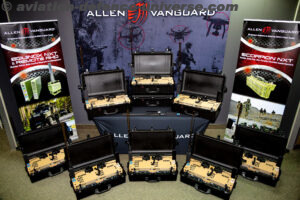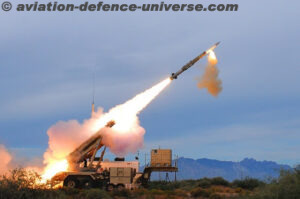- Hardware and software updates to improve guidance, range and performance
Tucson, Arizona. 16 December 2021. The AMRAAM missile development effort called F3R – form, fit, function refresh – is in news because the medium-range missile is being upgraded to address rapidly evolving threats. The new missile, with its improved guidance circuitry and software, supports the U.S. military’s imperative to upgrade existing technologies and keep pace with rapidly evolving threats.
“To be stronger, we are going to have to change. Our strategic competitors have studied how we fight and they have taken asymmetric steps to exploit our vulnerabilities and to defeat us,” U.S. Air Force Secretary Frank Kendall said at the Air Force Association’s 2021 Air, Space & Cyber Conference. “We have to respond with a sense of urgency, but we also have to take the time necessary to make smart choices about our future and our investments.”
The AMRAAM missile is among those investments. It has long been a trusted part of the U.S. arsenal, and has over time been enhanced with longer range, GPS-aided navigation and a two-way data link to improve its overall effectiveness.
“Today’s AMRAAM is a mature, highly advanced, intelligent weapon we continually innovate and modernize,” said Paul Ferraro, vice president of Air Power at Raytheon Missiles & Defense, a Raytheon Technologies business. “It helps to maintain air dominance for the U.S. and its allies around the globe, and the F3R refresh will ensure it continues to do so well into the future.”
In use by 41 nations, the AMRAAM missile is flying on the F-15C Eagle and F-15E Strike Eagle, F-16 Fighting Falcon, F/A-18 C/D Hornet and F/A-18E/F Super Hornet, F-22 Raptor, Eurofighter Typhoon, JAS-39 Gripen, Panavia Tornado and Harrier Jump Jet. It is also the only air-to-air missile qualified on the F-35 Joint Strike Fighter.
The F3R effort included the use of digital technologies such as model-based system engineering to upgrade 15 circuit cards in the missile’s guidance section. The missile will have new software as well.
“It’s a two for one,” Ferraro said.
As part of the F3R updates, Raytheon Missiles & Defense also plans to modify the AMRAAM design to accommodate new parts and keep it ahead of modern threats. At the same time, they’ll bring in new processors, for example, that are able to incorporate more advanced algorithms and can calculate faster.
“It all translates into better performance for the end user – the U.S. Air Force, the U.S. Navy and foreign military sales customers,” Ferraro said.
Raytheon Missiles & Defense is producing a set of AMRAAM missiles known as Lot 34. Under a $518 million contract with the U.S. Air Force, the business will use digital technologies to build those weapons faster and at a lower cost than previously possible.
Separately, Raytheon Missiles & Defense will also use digital design and manufacturing to produce new AMRAAM-Extended Range missiles, which launch from the surface as part of ground-based air defense systems.
For the F3R refresh, the business is using a tool it calls “M-Sim,” short for emulation simulation, to emulate hardware on circuit cards so that software designers can rapidly build, test and integrate software into hardware.
Integrating the F3R variant onto several fourth- and fifth-generation aircraft requires testing – and a lot of it.
Raytheon Missiles & Defense and the Air Force successfully completed the latest series of captive flight tests, which involved flying an instrumented captive missile on multiple F-15, F-16 and F/A-18 air-to-air intercept missions.
It was the most strenuous testing to date that included stressing the latest F3R hardware and a robust sustainment program called System Improvement Program, or SIP 3F, software updates.
“We continue to keep the hardware out in the field relevant through software upgrades,” said Steve Dickman, executive director for Air Dominance at Raytheon Missiles & Defense.
The tests included demonstrating how the weapon works in a realistic environment.
“We can simulate a lot in our laboratory, but there’s nothing like the real-world environment where we’re able to prove out our capability,” Dickman said.
Data gathered from these flight tests will be used to fine-tune the software, which will undergo further testing in late 2021, followed by live-fire tests in 2022. The business expects to deliver the F3R variant in 2023.
“It sets us up for the future of AMRAAM – to bring more capability to our customers,” Dickman said.
The AMRAAM missile is the baseline weapon on the National Advanced Surface-to-Air Missile System, or NASAMS, allowing countries to use the same missile in both air-to-air and surface-launch engagements with no modifications.
During a live-fire exercise in September 2021, the Royal Norwegian Air Force fired an AMRAAM-ER missile from a NASAMS launcher, successfully engaging and destroying a high-speed jet target drone.
“Modern warfare is a constantly changing dynamic. The U.S. and its allies must be ready to stay ahead of the threat,” Dickman said. “We must be able to operate in a dense electronic attack environment with countermeasures that the enemy might take.”
Raytheon Missiles & Defense is partnering with Norwegian industry and Ministry of Defence to develop the next variant of AMRAAM-ER, which is integrated into the NASAMS launcher.
The AMRAAM-ER missile has a rocket motor built by the Norwegian defense company Nammo. The missile intercepts at longer ranges and higher altitudes than other surface-launched effectors.
The business is working with Nammo to develop an improved rocket motor for the AMRAAM-E2 variant and also with KONGSBERG on a new control actuation system.






























































































































